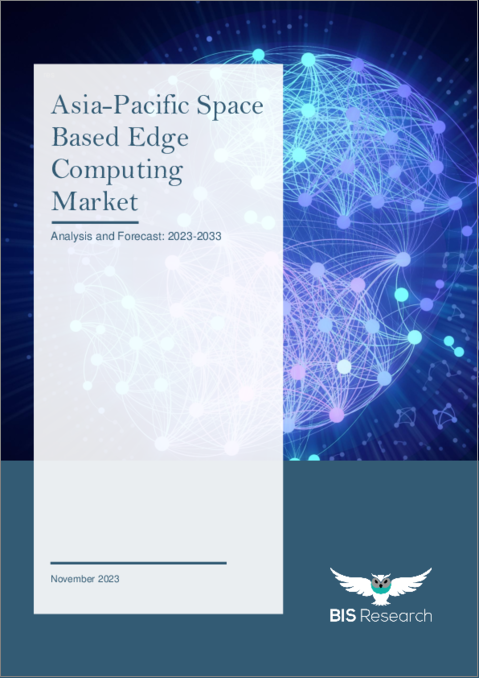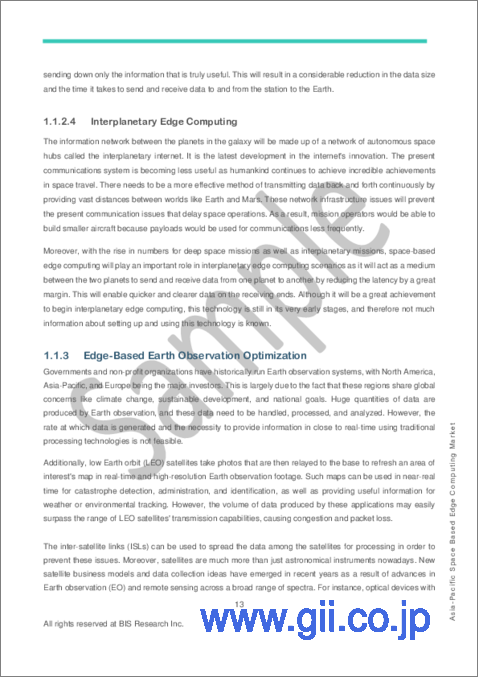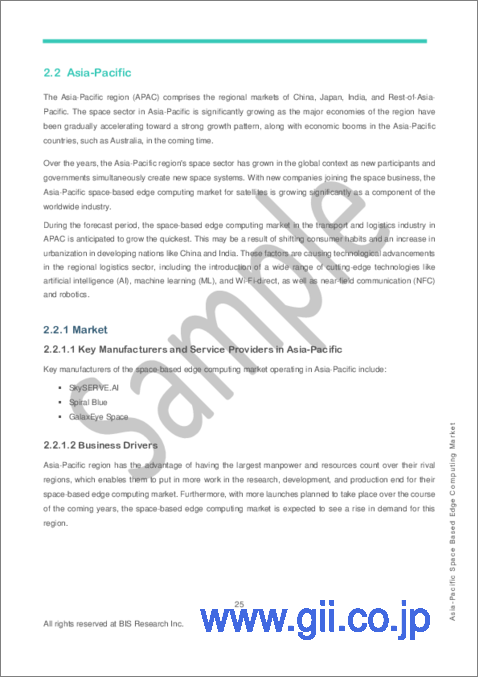|
|
市場調査レポート
商品コード
1379168
アジア太平洋地域の宇宙ベースエッジコンピューティング市場:2023-2033年Asia-Pacific Space Based Edge Computing Market - Analysis and Forecast, 2023-2033 |
||||||
カスタマイズ可能
|
|||||||
| アジア太平洋地域の宇宙ベースエッジコンピューティング市場:2023-2033年 |
|
出版日: 2023年11月10日
発行: BIS Research
ページ情報: 英文 63 Pages
納期: 1~5営業日
|
全表示
- 概要
- 図表
- 目次
アジア太平洋地域の宇宙ベースエッジコンピューティングの市場規模は、2022年の2,010万米ドルから、予測期間中は22.74%のCAGRで推移し、2033年には1億8,180万米ドルの規模に成長すると予測されています。
同市場の成長を牽引しているのは、新技術の開発と軍需産業のニーズの高まりです。
1990年代にAkamaiのコンテンツデリバリーネットワーク (CDN) が導入され、エッジコンピューティングが誕生しました。エッジコンピューティングの市場はそれ以来拡大しており、今後も拡大が見込まれています。宇宙空間で移動するデータセンターへのニーズと宇宙空間での遅延短縮へのニーズが高まっていることから、エッジコンピューティングのひとつである宇宙ベースエッジコンピューティングの人気が高まっています。
現在、地球低軌道 (LEO) 衛星のコンステレーション開発は、多くの宇宙機関や民間企業にとって優先事項となっており、宇宙ベースエッジコンピューティングの市場はこれによって牽引されると考えられています。R&D努力の増大によるコスト効率の高いエッジコンピューティングコンポーネントの開発も市場を促進する要因のひとつです。
当レポートでは、アジア太平洋地域の宇宙ベースエッジコンピューティングの市場を調査し、市場概要、市場成長への各種影響因子の分析、法規制環境、市場規模の推移・予測、各種区分・地域/主要国別の詳細分析、競合情勢、主要企業の分析などをまとめています。
| 主要市場統計 | |
|---|---|
| 予測期間 | 2023-2033年 |
| 2023年評価 | 2,340万米ドル |
| 2033年予測 | 1億8,180万米ドル |
| CAGR | 22.74% |
市場区分:
セグメンテーション1:エンドユーザー別
- 商業
- 防衛
- 民間政府
セグメンテーション2:国別
- 中国
- インド
- 日本
- その他のアジア太平洋地域
目次
第1章 市場
- 業界の展望
- 世界の宇宙ベースエッジコンピューティング市場:概要
- 現在および新たな技術動向
- エッジベースの地球観測の最適化
- 新興の小型衛星コンステレーション (0~600Kg) :宇宙ベースエッジコンピューティングソリューションの成長機会
- 進行中のプロジェクトと今後のプロジェクト
- 価格分析:地上波、クラウドコンピューティング、エッジコンピューティング
- スタートアップと投資シナリオ
- バリューチェーン分析
第2章 アジア太平洋
- 世界の宇宙ベースエッジコンピューティング市場 (地域別)
- アジア太平洋
- 市場
- 用途
- アジア太平洋 (国別)
第3章 市場:競合ベンチマーキング・企業プロファイル
- 競合ベンチマーキング
- AICRAFT
- Spiral Blue
- SkyServe
- 企業概要
- 経営戦略
- アナリストの見解
第4章 調査手法
List of Figures
- Figure 1: Asia-Pacific Space-Based Edge Computing Market, $Million, 2022-2033
- Figure 2: Asia-Pacific Space-Based Edge Computing Market (by End User), $Million, 2022 and 2033
- Figure 3: Asia-Pacific Space-Based Edge Computing Market (by Component), $Million, 2022 and 2033
- Figure 4: Asia-Pacific Space-Based Edge Computing Market (by Region), $Million, 2033
- Figure 5: Value Chain Analysis of the Asia-Pacific Space-Based Edge Computing Market
- Figure 6: Asia-Pacific Space-Based Edge Computing Market, Competitive Benchmarking
- Figure 7: Research Methodology
- Figure 8: Top-Down and Bottom-Up Approach
- Figure 9: Assumptions and Limitations
List of Tables
- Table 1: Terrestrial Model Pricing
- Table 2: Cloud Computing Model Pricing
- Table 3: Edge Computing Model Pricing
- Table 4: Startups and Investment Scenarios
- Table 5: Global Space-Based Edge Computing Market (by Region), 2022-2033
- Table 6: Asia-Pacific Space-Based Edge Computing Market (by End User), $Million, 2022-2033
- Table 7: China Space-Based Edge Computing Market (by End User), $Million, 2022-2033
- Table 8: Japan Space-Based Edge Computing Market (by End User), $Million, 2022-2033
- Table 9: India Space-Based Edge Computing Market (by End User), $Million, 2022-2033
- Table 10: Rest-of-Asia-Pacific Space-Based Edge Computing Market (by End User), $Million, 2022-2033
- Table 11: Benchmarking and Weightage Parameters
- Table 12: AICRAFT: Product Portfolio
- Table 13: AICRAFT: New Product Launch and Merger and Acquisition
- Table 14: Spiral Blue: Product Portfolio
- Table 15: Spiral Blue: Partnerships, Collaborations, Agreements, and Contracts
- Table 16: SkyServe: Service Portfolio
- Table 17: SkyServe: Partnerships, Collaborations, Agreements, Investments, and Contracts
“The Asia-Pacific Space Based Edge Computing Market Expected to Reach $181.8 Million by 2033.”
| KEY MARKET STATISTICS | |
|---|---|
| Forecast Period | 2023 - 2033 |
| 2023 Evaluation | $23.4 Million |
| 2033 Forecast | $181.8 Million |
| CAGR | 22.74% |
Introduction to Asia Pacific (APAC) Space-Based Edge Computing Market
The APAC Space-Based Edged Computing Market is expected to grow at a CAGR of 22.74% from $20.1 million in 2022 to $181.8 million by 2033 in the forecasted period of 2023-2033. The two primary sectors of the APAC space-based edge computing market are end users and component makers. The hardware and software utilized in space-based edge computing systems are developed and provided by component manufacturers. Organizations that collect and analyze data using space-based edge computing systems are known as end users. In the upcoming years, the APAC space-based edge computing market is anticipated to experience significant expansion. The market is being driven by new technology development and the military industry's increasing need.
Market Introduction
With the introduction of Akamai's content delivery network (CDN) in the 1990s, edge computing came into being. The plan was to physically relocate nodes in order to provide stored media, such as images and videos, closer to the user. The first desktop computers were developed in the late 1970s, during which time major tech companies such as IBM, Intel, Microsoft, and Apple started to appear. This was made possible by the advancement of microprocessors and other micro-tech. The market for edge computing has expanded since then and is expected to do so in the future. The increasing need for moving data centers in space and for latency reduction in space has led to a rise in popularity for one aspect of edge computing: space-based edge computing.
At the moment, low Earth orbit (LEO) satellite constellation development is a major global priority for numerous space agencies and commercial enterprises. The market for space-based edge computing would be driven by this. The development of cost-effective edge computing components through increased research and development efforts is another driver fueling the market for space-based edge computing.
Market Segmentation:
Segmentation 1: by End User
- Commercial
- Defense
- Civil Government
Segmentation 2: by Country
- China
- India
- Japan
- Rest-of-Asia-Pacific
How can this report add value to an organization?
Product/Innovation Strategy: The product segment helps the reader understand the different types of space-based edge computing markets available for deployment in the industries for space platforms and their potential in apac region. Moreover, the study provides the reader with a detailed understanding of the different space-based edge computing market by application (commercial, defense, and civil government).
Growth/Marketing Strategy: The APAC space-based edge computing market has seen major development by start-up players operating in the market, such as business expansion activities, contracts, mergers, partnerships, collaborations, and joint ventures. The favored strategy for the companies has been contracted to strengthen their position in the APAC space-based edge computing market.
Competitive Strategy: Key players in the APAC space-based edge computing market analyzed and profiled in the study involve space-based edge computing services and space-based edge computing product providers. Moreover, a detailed competitive benchmarking of the players operating in the APAC space-based edge computing market has been done to help the reader understand how players stack against each other, presenting a clear market landscape. Additionally, comprehensive competitive strategies such as contracts, partnerships, agreements, acquisitions, and collaborations will aid the reader in understanding the untapped revenue pockets in the market.
Key Market Players and Competition Synopsis
The companies that are profiled have been selected based on inputs gathered from primary experts and analysing company coverage, product portfolio, and market penetration.
Some of the prominent names established in this market are:
|
|
Table of Contents
1 Markets
- 1.1 Industry Outlook
- 1.1.1 Global Space-Based Edge Computing Market: Overview
- 1.1.2 Current and Emerging Technological Trends
- 1.1.2.1 Edge Computing With 5G
- 1.1.2.2 In-Orbit Data Centers
- 1.1.2.3 Edge Computing for Constellation Applications
- 1.1.2.4 Interplanetary Edge Computing
- 1.1.3 Edge-Based Earth Observation Optimization
- 1.1.4 Emerging Small Satellite Constellations (0-600Kg): A Growth Opportunity for Space-Based Edge Computing Solutions, 2023-2033
- 1.1.5 Ongoing and Upcoming Projects
- 1.1.5.1 ISS-HPE Spaceborne Computer
- 1.1.5.2 Space-Based Data Centers
- 1.1.6 Pricing Analysis: Terrestrial vs. Cloud Computing vs. Edge Computing
- 1.1.7 Startups and Investment Scenarios
- 1.2 Value Chain Analysis
2 Asia-Pacific
- 2.1 Global Space-Based Edge Computing Market (by Region)
- 2.2 Asia-Pacific
- 2.2.1 Market
- 2.2.1.1 Key Manufacturers and Service Providers in Asia-Pacific
- 2.2.1.2 Business Drivers
- 2.2.1.3 Business Challenges
- 2.2.2 Application
- 2.2.2.1 Asia-Pacific Space-Based Edge Computing Market (by End User)
- 2.2.3 Asia-Pacific (by Country)
- 2.2.3.1 China
- 2.2.3.1.1 Application
- 2.2.3.1.1.1 China Space-Based Edge Computing Market (by End User)
- 2.2.3.1.1 Application
- 2.2.3.2 Japan
- 2.2.3.2.1 Market
- 2.2.3.2.1.1 Key Manufacturers and Service Providers in Japan
- 2.2.3.2.2 Application
- 2.2.3.2.2.1 Japan Space-Based Edge Computing Market (by End User)
- 2.2.3.2.1 Market
- 2.2.3.3 India
- 2.2.3.3.1 Market
- 2.2.3.3.1.1 Key Manufacturers and Service Providers in India
- 2.2.3.3.2 Application
- 2.2.3.3.2.1 India Space-Based Edge Computing Market (by End User)
- 2.2.3.3.1 Market
- 2.2.3.4 Rest-of-Asia-Pacific
- 2.2.3.4.1 Market
- 2.2.3.4.1.1 Key Manufacturers and Service Providers in Rest-of-Asia-Pacific
- 2.2.3.4.2 Application
- 2.2.3.4.2.1 Rest-of-Asia-Pacific Space-Based Edge Computing Service Market (by End User)
- 2.2.3.4.1 Market
- 2.2.3.1 China
- 2.2.1 Market
3 Markets - Competitive Benchmarking & Company Profiles
- 3.1 Competitive Benchmarking
- 3.2 AICRAFT
- 3.2.1 Company Overview
- 3.2.1.1 Role of AICRAFT in Asia-Pacific Space-Based Edge Computing Market
- 3.2.1.2 Product Portfolio
- 3.2.2 Business Strategies
- 3.2.2.1 New Product Launch and Merger and Acquisition
- 3.2.3 Analyst View
- 3.2.1 Company Overview
- 3.3 Spiral Blue
- 3.3.1 Company Overview
- 3.3.1.1 Role of Spiral Blue in Asia-Pacific Space-Based Edge Computing Market
- 3.3.1.2 Product Portfolio
- 3.3.2 Corporate Strategies
- 3.3.2.1 Partnerships, Collaborations, Agreements, and Contracts
- 3.3.3 Analyst View
- 3.3.1 Company Overview
- 3.4 SkyServe
- 3.4.1 Company Overview
- 3.4.1.1 Role of SkyServe in Asia-Pacific Space-Based Edge Computing Market
- 3.4.1.2 Service Portfolio
- 3.4.2 Corporate Strategies
- 3.4.2.1 Partnerships, Collaborations, Agreements, and Contracts
- 3.4.3 Analyst View
- 3.4.1 Company Overview
4 Research Methodology
- 4.1 Factors for Data Prediction and Modeling






